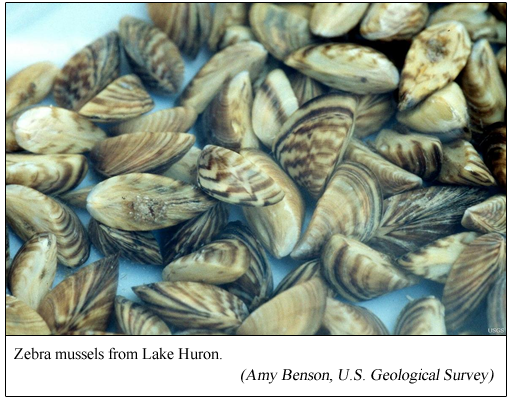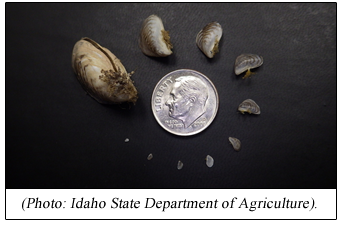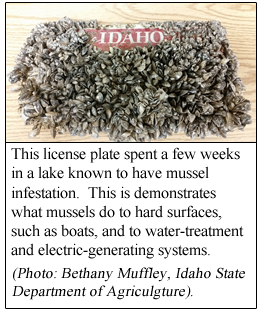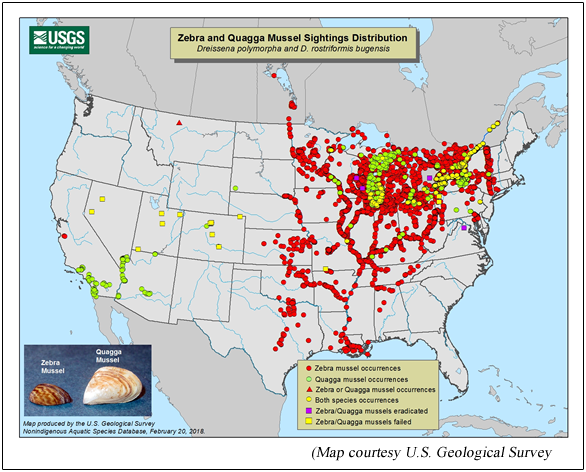|
Part 1: Invasive mussel species are
getting so bad, the government started a
contest. First, some background . . . |
|
2 March 2018 |
We’re going to talk a little about invasive
species here. Specifically invasive mussels.
Why? Because they are a big threat to invade
Idaho’s beautiful waterways, and if that should
happen, that would change many things for the
worse. And, because there is a nationwide
contest underway seeking ideas to eliminate
these invasive mussels. That’s kind of unusual,
and we thought you might want to know about it.
(Story continues below this photograph)

You’ve seen the boat inspection stations located
around our state. Our closest inspection station
is at the Samuels gas station on Highway 95
between Bonners Ferry and Sandpoint. These
stations search for invasive species that are
considered to be detrimental to Idaho’s waters
and vegetation. The two big aquatic invaders of
concern these days are quagga mussels and zebra
mussels.
Native to the Black, Caspian, and Azov seas,
these mussels were first found in North American
in the Great Lakes in the 1980s. They are
believed to have been carried to the Great Lakes
via ships from those Eurasian lakes or other
areas the mussels had invaded.
 These non-native species cause considerable
damage when they take up new homes. Their
colonization of new areas alters habitat
complexity and displaces native species. Their
tendency to adhere to the shells of native
mussels impacts feeding, breeding, and movement
of native mussels, eventually killing them. They
alter food webs, negatively impacting food
sources for fish and other aquatic organisms.
Their feeding methods tend to lead to longer
term diversion of energy and nutrients to the
lake bottoms, which in turn promotes the growth
of lake bottom nuisance algae. These mussels
also promote the growth of the bacteria that
produces a type of botulism, which has led to
thousands of waterbird deaths at the Great
Lakes. They attach to hard surfaces such as
water intake structures and other underwater
structures, clogging them and causing
inefficient operation. See, for example, the
photograph accompanying this article of an Idaho
license plate covered with attached mussels. These non-native species cause considerable
damage when they take up new homes. Their
colonization of new areas alters habitat
complexity and displaces native species. Their
tendency to adhere to the shells of native
mussels impacts feeding, breeding, and movement
of native mussels, eventually killing them. They
alter food webs, negatively impacting food
sources for fish and other aquatic organisms.
Their feeding methods tend to lead to longer
term diversion of energy and nutrients to the
lake bottoms, which in turn promotes the growth
of lake bottom nuisance algae. These mussels
also promote the growth of the bacteria that
produces a type of botulism, which has led to
thousands of waterbird deaths at the Great
Lakes. They attach to hard surfaces such as
water intake structures and other underwater
structures, clogging them and causing
inefficient operation. See, for example, the
photograph accompanying this article of an Idaho
license plate covered with attached mussels.
Estimated costs for controlling these mussels
and their costs impacting electric-generation
and water-treatment facilities in the United
states range in the hundreds of millions of
dollars annually.
One type of hard surface to which these mussels
attach is boats. It is believed that overland
transport of watercraft and equipment is one of
the main ways these mussels move to new areas.
They can live out of water for several days, so
mussel spread by boats, both commercial and
recreational, that are trailered from place to
place and from one body of water to another, is
a high-risk way for mussels to spread and to be
carried to areas, such as Idaho, where they have
not yet colonized. And that is why we have
inspection stations: to find and eliminate
mussels that might be transported into Idaho by
unsuspecting boat owners entering Idaho from
other areas where these mussels are already
established. watercraft and equipment is one of
the main ways these mussels move to new areas.
They can live out of water for several days, so
mussel spread by boats, both commercial and
recreational, that are trailered from place to
place and from one body of water to another, is
a high-risk way for mussels to spread and to be
carried to areas, such as Idaho, where they have
not yet colonized. And that is why we have
inspection stations: to find and eliminate
mussels that might be transported into Idaho by
unsuspecting boat owners entering Idaho from
other areas where these mussels are already
established.
Take a look at the U.S. Geological Survey map
included with this story. It shows that only a
few waterway systems in the United States remain
unaffected by mussels, and only a few states are
unaffected. So far, Idaho has had no permanent
colonization from these invasive mussels, and
the Columbia River system, the major waterway
system of the Pacific Northwest, remains free of
colonization to date.
And that is why our state, and many other
states, put the effort and money into those boat
and watercraft inspection stations. There are 20
such stations in Idaho, and three mobile
inspection units traveling the highways.
According to the website of the Idaho State
Department of Agriculture, over half a million
inspections have been conducted since the
program was begun in 2009. So far, those
stations have intercepted and cleaned 218
mussel-fouled boats since 2009, boats that
otherwise might have transported those mussels
directly into Idaho waters.
Two mussel-infested boats have already been
detected in 2018 in Idaho. Both of these were
traveling on Highway 93, which runs through Twin
Falls and Salmon, Idaho in the southern Idaho
area. Both of those boats had originated from
Arizona.
(Story continues below this photograph)

To see a larger size version of this map,
click here.
So what can we do to keep those invasive mussels
out? Some believe keeping them out will
ultimately be impossible. To give it our best
effort, here is what we can do: Check boats
thoroughly for mussels before putting them into
lakes and rivers, and check for mussels when
they are removed from waterways. Be particularly
vigilant if your boat has been used in another
state. Next, stop at those inspection stations.
Aside from it being illegal to bypass them if
you have a boat, stopping there will be doing
one of the few things we can to try to block the
advance of these dangerous invasive mussels into
the relatively pristine waters of our state.
Finally, now that we have a better understanding
of the problem, let’s be patient and nice with
those folks who man those stations. They really
aren’t there to harass us, they are serving on
the front lines of keeping those mussels out.
This brings us now to an innovative and unusual
plan to find some way that will effectively
combat these mussels. Sounds kind of crazy, but
the Bureau of Reclamation has put together a
contest, with a $100,000 prize, to find a way to
eradicate invasive zebra and quagga mussels. The
competition received 99 entries from people with
ideas and plans for this eradication.
To learn more about this mussel eradication idea
competition, move on to read the companion
article listed right after this exciting article
in NewsBF. You should be able to find the
companion article about the contest listed right
after this article. The Part 2 companion article
originally appeared in the Columbia Basin
Bulletin. It can be found right here on
NewsBF, and is entitled Bureau Receives
99 Proposals in Competition for Solutions to
Stop Spread of Invasive Mussels. |
|
Questions or comments about this
letter?
Click here to e-mail! |
|
|
|
|

